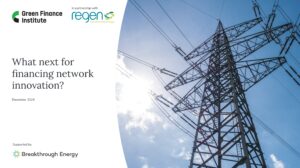Private finance in network innovation

by
With power and gas networks dating back to the early 1900s, the UK has one of the world’s oldest and most developed energy networks. Now, with ambitious net zero power targets, energy networks are rapidly evolving, requiring bold investment and innovation to deliver.
The Labour government has set out a manifesto pledge for all UK power to be net zero by 2030. Achieving this ambition will transform energy networks, with increasing amounts of power generation coming from renewable sources, including 50GW of offshore wind connected by 2030, and huge increases in flexible generation and consumption changing the way households and businesses interact with the energy system.
Delivering the scale and pace of change required necessitates innovation in the energy networks sector, yet known investment gaps of £1.5bn[1] threaten to stifle progress at the very moment we need to accelerate.
Supported by Breakthrough Energy, Green Finance Institute, in partnership with Regen, has sought to understand the causes of this investment gap while mapping out solutions that should be further investigated and developed.
In producing this ‘greenprint’, researchers engaged with dozens of key stakeholders, from regulators to energy networks, innovation companies and the investment community. 13 key barriers have been identified across four key themes.
- Timelines: innovation activities in the energy networks sector have long time horizons, creating funding gaps and more piecemeal approaches to innovation.
- Approach to risk: network companies tend to be risk-averse, due in part to the regulatory environment and their primary function of keeping the lights on. This affects their appetite to support more disruptive or radical solutions which come with greater risks.
- Market access: innovators and investors both face challenges engaging with the networks market. Innovators often face challenges in the early stages of development to sell and scale their products, while investors lack clarity on the future size of the opportunity and how to navigate technology and regulatory risks.
- Knowledge: Investors’ perception of energy networks tends to be negative compared to other cleantech markets due to the fully regulated market model. Further to this , complex IP arrangements in publicly funded innovation projects creates further risk for private investors and innovators alike.
While the barriers identified are complex and interrelated, stakeholders across the network, innovation and investment sectors are confident that solutions exist to create an environment that can accelerate innovation and drive increased investment from private finance.
Stakeholders agreed that the regulatory framework is critical for incentivising network innovation, and reforms to the current regime can address some of the cultural challenges impacting timelines and risk adversity.
Such reform must be aligned with wider policy at a time when bold national policy is shifting the direction of travel and measures of success for the energy sector. Harmonising regulatory reform and policy changes can help to develop clearly defined sectoral pathways which flow from national policy and allow investors to more clearly identify market sizes and opportunities, helping scale the whole market and not just support the success of a few first of a kind projects.
There is also an opportunity for innovation financial mechanisms to be developed and scaled to support innovators and further encourage investors to channel funds into accelerating network innovation. Blended finance models could work as an equity escalator to bridge funding gaps, while existing products such as green bonds, technology performances guarantees and insurance risk pools or mutuals can all be adapted to encourage greater flows of private investment in the network innovation. This would also allow public funding to achieve a greater catalytic effect for private capital while maintaining some concessionality for recipients.
In developing this greenprint for using private finance to accelerate innovation, it is clear the current framework for network innovation is creating significant barriers to private investment, threatening the rapid progress we need to make to achieve clean power targets.
But by developing new financial models for network investment and delivering these alongside regulatory reform, harmonised with national policy, the opportunity exists to transform the investment environment for network innovation and supercharge progress towards Clean Power 2030.
[1] Clean Tech for UK, Building the next generation of cleantech champions. UK landscape overview








